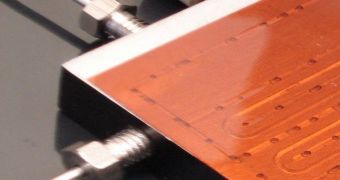For the past two decades, microfluidic devices have been a subject of avid research in the international scientific community, on account of the benefits it could bring to areas such as physics, chemistry and medicine. But experts have always relied on the same type of approach when designing their labs-on-a-chip, regardless of the application they were designing the instruments for. Now, scientists at the University of Cincinnati have developed an entirely-different approach to constructing these devices.
Standard labs-on-a-chip relay on regular pressure, or on electrokinetic forces, to move liquid samples around through very thin channels, made either out of glass or silica. Depending on what is inserted in these very thin channels, the liquids undergo various modifications, and these changes can be used to either create potable water, or diagnose diseases, test for contaminants and a myriad of other applications.
The UC team is currently proposing the development of a new class of microfluidic devices, one that would feature instruments capable of changing the configuration of the channels they contain. This could mean that the new labs would enable for a single apparatus to be used for a wide variety of applications. “In microfluidics, we typically work with either continuous flows which give us high throughputs or droplets (digital flows) that can be manipulated electrically,” explains UC associate professor of electrical engineering, Ian Papautsky. He is also the director of both the BioMicroSystems Lab, and the Micro/Nano Fabrication Engineering Research Center, at the university.
“In our new collaboration with Jason Heikenfeld, we are merging these two paradigms into a programmable microfluidic system. This is especially exciting because traditionally all lab-on-a-chip devices are limited by the predefined microchannel structure. A programmable microfluidics platform would offer an ability to reconfigure microchannel structure as needed for performing a wide range of biomedical assays, from DNA analysis to immunoassays, on the same chip. I am excited to see our work so well received,” he adds.

 14 DAY TRIAL //
14 DAY TRIAL //